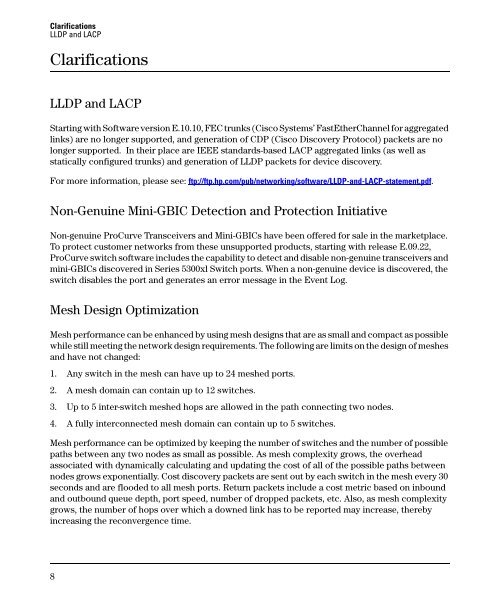Release Notes: Version E.10.37 Software
Release Notes: Version E.10.37 Software
Release Notes: Version E.10.37 Software
Create successful ePaper yourself
Turn your PDF publications into a flip-book with our unique Google optimized e-Paper software.
Clarifications<br />
LLDP and LACP<br />
Clarifications<br />
LLDP and LACP<br />
Starting with <strong>Software</strong> version E.10.10, FEC trunks (Cisco Systems’ FastEtherChannel for aggregated<br />
links) are no longer supported, and generation of CDP (Cisco Discovery Protocol) packets are no<br />
longer supported. In their place are IEEE standards-based LACP aggregated links (as well as<br />
statically configured trunks) and generation of LLDP packets for device discovery.<br />
For more information, please see: ftp://ftp.hp.com/pub/networking/software/LLDP-and-LACP-statement.pdf.<br />
Non-Genuine Mini-GBIC Detection and Protection Initiative<br />
Non-genuine ProCurve Transceivers and Mini-GBICs have been offered for sale in the marketplace.<br />
To protect customer networks from these unsupported products, starting with release E.09.22,<br />
ProCurve switch software includes the capability to detect and disable non-genuine transceivers and<br />
mini-GBICs discovered in Series 5300xl Switch ports. When a non-genuine device is discovered, the<br />
switch disables the port and generates an error message in the Event Log.<br />
Mesh Design Optimization<br />
Mesh performance can be enhanced by using mesh designs that are as small and compact as possible<br />
while still meeting the network design requirements. The following are limits on the design of meshes<br />
and have not changed:<br />
1. Any switch in the mesh can have up to 24 meshed ports.<br />
2. A mesh domain can contain up to 12 switches.<br />
3. Up to 5 inter-switch meshed hops are allowed in the path connecting two nodes.<br />
4. A fully interconnected mesh domain can contain up to 5 switches.<br />
Mesh performance can be optimized by keeping the number of switches and the number of possible<br />
paths between any two nodes as small as possible. As mesh complexity grows, the overhead<br />
associated with dynamically calculating and updating the cost of all of the possible paths between<br />
nodes grows exponentially. Cost discovery packets are sent out by each switch in the mesh every 30<br />
seconds and are flooded to all mesh ports. Return packets include a cost metric based on inbound<br />
and outbound queue depth, port speed, number of dropped packets, etc. Also, as mesh complexity<br />
grows, the number of hops over which a downed link has to be reported may increase, thereby<br />
increasing the reconvergence time.<br />
8
















